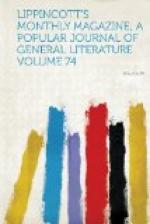Shakespeare’s forte lay in characterization, and that endlessly diversified. But when he sketched each several character it seems that he was never content till he had either found or fabricated the aptest words possible for representing its form and pressure most true to life. No two characters being identical in any particular more than two faces are, no two descriptions, as drawn by his genius, could repeat many of the selfsame characterizing words. Each of his vocables thus became like each of the seven thousand constituents of a locomotive, which fits the one niche it was ordained to fill, but everywhere else is out of place, and even dislocated. The more numerous his ethical differentiations, the more his language was differentiated.
His personages were as multifarious as have been portrayed by the whole band of Italian painters; but, as a wizard in words, he resembled the magician in mosaic, who can delineate in stone every feature of those portraits because he can discriminate and imitate shades of color more numberless than even Shakespeare’s words.
It is hard to believe that the Shakespearian characters were born, like Athene from the brain of Zeus, in panoplied perfection. They grew. The play of Troilus was a dozen years in growth. According to the best commentators, “Shakespeare, after having sketched out a play on the fashion of his youthful taste and skill, returned in after years to enlarge it, remodel it, and enrich it with the matured fruits of years of observation and reflection. Love’s Labor Lost first appeared in print with the annunciation that it was ‘newly corrected and augmented,’ and Cymbeline was an entire rifacimento of an early dramatic attempt, showing not only matured fulness of thought, but laboring intensity of compressed expression.” So speaks Verplanck, and his utterance is endorsed by Richard Grant White.
Such being the facts, it is clear that Shakespeare treated his dramas as Guido did the Cleopatra, which he would not let leave his studio till ten years after the non-artistic world deemed that portrait fully finished. Meantime, the painter in moments of inspiration was pencilling his canvas with curious touches, each approximating nearer his ideal. So the poet sought to find out acceptable words, or what he terms “an army of good words.” He poured his new wine into new bottles, and never was at rest till he had arrayed his ideas in that fitness of phrase which comes only by fits.
Had he survived fifty years longer, I suppose he would to the last have been perfecting his phrases, as we read in Dionysius of Halicarnassus that Plato up to the age of eighty-one was “combing and curling, and weaving and unweaving, his writings after a variety of fashions.” Possibly, the great dramatist would at last have corrected one of his couplets as a modern commentator has done for him, so that it would stand,
Find leaves on trees, stones
in the running brooks,
Sermons in books, and all
in everything.




